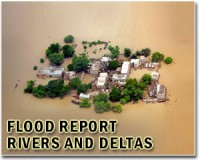 |
Ottawa, Canada (SPX) Mar 31, 2011 Extreme precipitation events seem to be becoming more common in the Northern Hemisphere. But it's been very hard for scientists to pinpoint a major weather event to global warming. Still, when a 100-year flood comes and then returns in a matter of a few years, it's hard not to consider it a sign of a warming world. Several papers published in the journal Nature demonstrate that such extreme precipitation events in specific localities is the result of climate change and not an overactive imagination. The scientists studied the actual, observable precipitation patterns in the 20th century and then compared them to climate model simulations and a splash of probability to discover a close, predictive match up. They claim that their results provide "first formal identification of a human contribution to the observed intensification of extreme precipitation." The scientists, led by Seung-Ki Min at the Climate Research Division from Environment Canada in Toronto, say that the global climate models may, in fact, be underestimating the amount of extreme weather events, "which implies that extreme precipitation events may strengthen more quickly in the future than projected and that they may have more severe impacts than estimated." In another study, this one led by Pardeep Pall at the University of Oxford, looked at a specific weather event: the 2000 floods in England and Wales, which occurred during the wettest autumn since 1766. About 10,000 properties were flooded over, causing evacuations, disruptions in rail service and power supplies, and an economic dent of about a Pounds 1 billion. Oxford scientists used a climate model and simulated different scenarios of rainfall patterns based on greenhouse gas levels in the atmosphere. The results were fed into a model that simulated severe river runoff and found that in nine out of 10 cases, the model forecast an increased risk of floods when 20th century levels greenhouse gases were included. Specifically, the increase in risk for floods in the autumn of 2000 in England and Wales was more 20 percent, and in two out of three cases more than 90 percent. The scientists conclude that human-caused greenhouse gas emissions contributed to the flood risk in England and Wales in 2000. With such techniques, scientists are coming closer to determining which weather events are nothing more than the result of statistical flukes, and which may seem like aberrant behavior but are really right in line with what we might expect from a warming world.
Climate change could signal prolonged droughts in American Southwest The American Southwest is already predicted to get pretty dry during climate change, due to a drop in winter precipitation that would increase evaporation rates and lead to smaller snow packs that normally provide water during the warmer months. Led by University of New Mexico earth scientist Peter Fawcett, the paper published in this week's journal Nature discusses the discovery of extreme arid conditions in the Valles Caldera region of New Mexico during the warmest phases of interglacials, when the mean annual temperature was comparable or higher to that of modern day temperatures. In one interglacial period they studied, temperatures rose almost 10 degrees Fahrenheit, leading at first to an abundance of vegetation such as oak and juniper that like warm conditions. However, as temperatures persisted the record shows a collapse in drought-resistant species and the Valles Caldera lake dried out, indicating a drought that scientists estimate lasted several thousand years. They write: Our results strongly indicate that interglacial climates in the southwestern US can experience prolonged periods of aridity, lasting centuries to millennia, with profound effects on water availability and ecosystem composition. The risk of prolonged aridity is likely to be heightened by anthropogenic forcing. The droughts they've studied make the 10-year Dust Bowl look like a blink in time.
Share This Article With Planet Earth
Related Links Environment Canada Bringing Order To A World Of Disasters When the Earth Quakes A world of storm and tempest
 Thai floods kill 15 dead, thousands stranded
Thai floods kill 15 dead, thousands strandedBangkok (AFP) March 30, 2011 Thailand mobilised its only aircraft carrier as efforts to rescue thousands trapped on storm-swept holiday islands intensified on Wednesday after severe flooding across the south killed 15. Victims were either swept away by the rising waters, or buried in mudslides as the unseasonably wet weather deluged the homes and businesses of around a million people in what should be one of the hottest ... read more |
|
| The content herein, unless otherwise known to be public domain, are Copyright 1995-2010 - SpaceDaily. AFP and UPI Wire Stories are copyright Agence France-Presse and United Press International. ESA Portal Reports are copyright European Space Agency. All NASA sourced material is public domain. Additional copyrights may apply in whole or part to other bona fide parties. Advertising does not imply endorsement,agreement or approval of any opinions, statements or information provided by SpaceDaily on any Web page published or hosted by SpaceDaily. Privacy Statement |